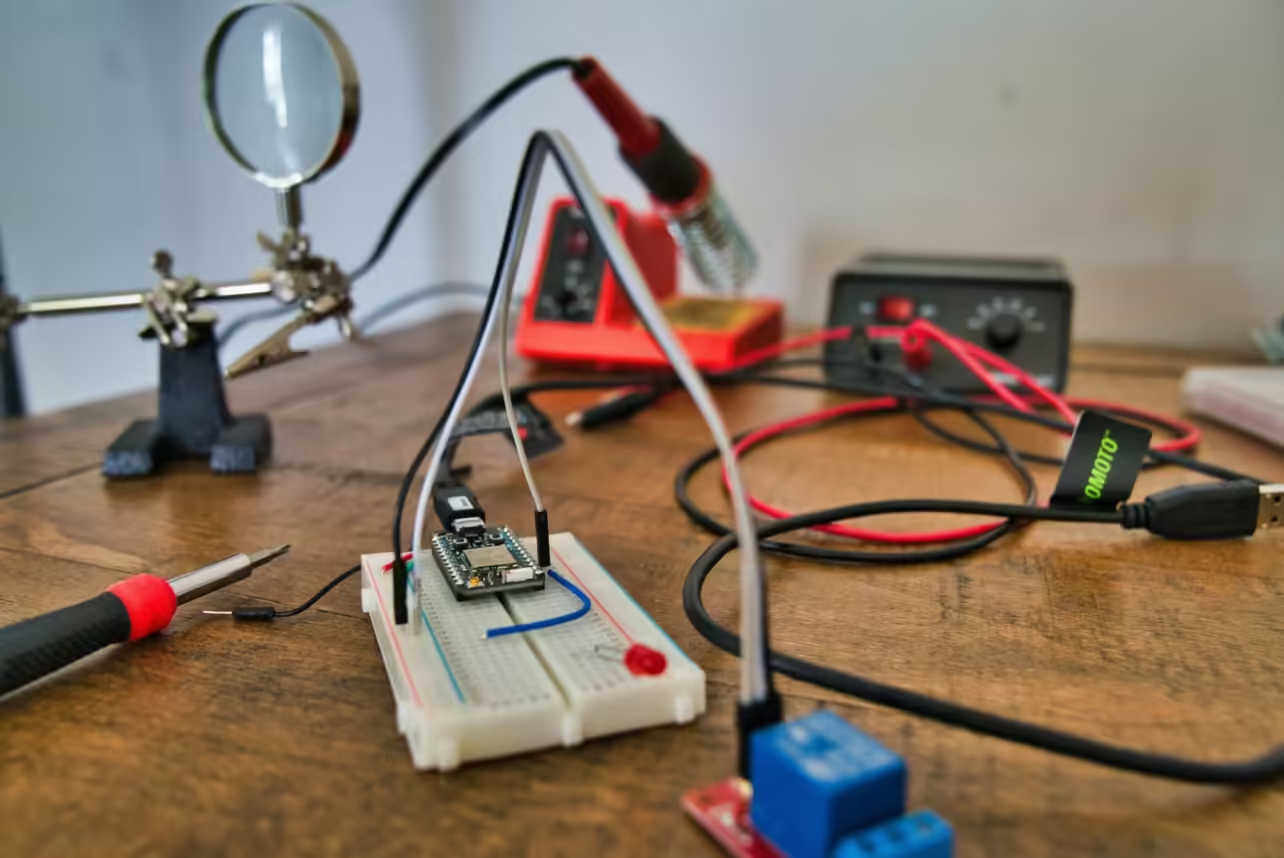- Introduction to Microcontrollers
- Microcontroller vs. Microprocessor, PLCs, and FPGAs
- Components of a Microcontroller
- Types of Microcontrollers
- How Microcontrollers Work
- Applications of Microcontrollers
- Programming Microcontrollers
- Choosing the Right Microcontroller
- Future Trends in Microcontrollers
- Conclusion
When I first joined the mechatronics field, one of my main questions was, “What is a microcontroller?” In our school’s Mechatronics club, they gave us an Arduino board and said it had an ATMega328 microcontroller. But I still didn’t understand what a microcontroller was and how it was different from the processors we usually hear about, like Intel processors. Now that I know more, I can help explain what microcontrollers are. So, let’s stick to this topic.
Introduction to Microcontrollers
Basic Definition and Functionality
A microcontroller, often referred to as an MCU (Microcontroller Unit), is a compact integrated circuit (IC) designed to govern a specific operation within an embedded system. Unlike general-purpose microprocessors found in personal computers, microcontrollers integrate a processor, memory, and input/output peripherals onto a single chip, optimizing them for control-oriented applications.
To my experience, microcontrollers are essential in many devices, from household appliances to industrial machines, because of their ability to efficiently manage specific tasks. They process inputs from sensors, execute pre-programmed instructions, and control outputs to actuators.
Microcontroller vs. Microprocessor, PLCs, and FPGAs
Microcontrollers vs. Microprocessors
Microcontrollers include built-in memory and peripherals, making them ideal for embedded applications. Microprocessors, on the other hand, require external components for memory and I/O functions, making them suitable for general-purpose computing.
Let’s take an example of an Intel Core i7 processor in a laptop versus an ATMega328 in an Arduino board. The Intel processor needs external RAM, storage, and peripherals, while the ATMega328 integrates everything on one chip.
Microcontrollers vs. PLCs (Programmable Logic Controllers)
PLCs are robust industrial computers designed for high-reliability control applications in harsh environments. They are used in industrial automation to control machinery and processes. Microcontrollers, while versatile, are not as rugged as PLCs and are used in a broader range of applications.
Imagine a PLC in a busy factory, flawlessly managing an entire assembly line. Now, picture a microcontroller in your smart home, adjusting the thermostat and turning on lights. While the PLC excels in industrial settings, the microcontroller brings convenience to your daily life.
Microcontrollers vs. FPGAs (Field-Programmable Gate Arrays)
FPGAs are reconfigurable logic devices used for high-performance and custom hardware designs. They are suitable for applications requiring parallel processing and hardware customization. Microcontrollers are fixed-function devices optimized for control tasks.
A case example of this, an FPGA handling high-speed data processing in real-time video streaming. In contrast, a microcontroller in a digital thermometer efficiently measures and displays body temperature. While the FPGA excels in complex, high-performance tasks, the microcontroller is perfect for simple, precise control functions.
We already discussed all these comparisons in separate and detailed articles. For more in-depth information and related topics, check out our detailed articles on PLCs, FPGAs, and other related technologies.
Components of a Microcontroller
Central Processing Unit (CPU)
The CPU is the brain of the microcontroller. It performs arithmetic operations, manages data flow, and executes instructions stored in the program memory. The CPU consists of the Arithmetic Logic Unit (ALU) and the Control Unit (CU), which together handle all processing tasks.
Memory
Microcontrollers typically have two types of memory: volatile memory (RAM) and non-volatile memory (Flash or EEPROM). RAM is used for temporary data storage, while Flash memory stores the program code that the CPU executes. EEPROM allows for the storage of data that needs to persist even when the device is powered off.
Let’s take a fun look at the ATMega328 microcontroller, a student favorite. Think of it as a tiny computer brain with 2KB of RAM (short-term memory), 32KB of Flash (long-term instructions), and 1KB of EEPROM (remembers important info even when off). It’s like a super-organized friend, perfect for our projects, though it can’t handle a big OS like Windows!
I/O Peripherals
I/O peripherals are the interface between the microcontroller and the external world. They include ports for digital input/output, analog-to-digital converters (ADC), digital-to-analog converters (DAC), and communication interfaces like UART, SPI, and I2C. These peripherals allow the microcontroller to interact with sensors, actuators, and other devices.
Timers and Counters
Microcontrollers often include timers and counters that help manage time-based functions such as generating precise time delays, measuring time intervals, and controlling the timing of processes.
A use case I think you and I’ve personally worked on: using timers in a microcontroller to control the blinking of an LED. Imagine the microcontroller as a maestro, precisely timing the LED’s blinks like a symphony conductor. By setting up timers, you can make the LED flash at exact intervals, creating anything from a simple blink to a complex light show. It’s a fantastic way to learn about timing and control in a hands-on, engaging way!
Types of Microcontrollers

8-bit Microcontrollers
These are the most basic and cost-effective microcontrollers, suitable for simple applications like toys and small household appliances. They have limited processing power and memory capacity.
Take the PIC16F84, for instance. It’s a favorite for basic educational projects, perfect for learning the basics of microcontroller programming through simple tasks like controlling LEDs or reading sensors. A great way to get hands-on experience!
16-bit Microcontrollers
More advanced than 8-bit microcontrollers, 16-bit MCUs are used in applications requiring higher processing capabilities, such as automotive systems and medical devices.
The MSP430 from Texas Instruments, often used in wearable medical devices, is known for its low power consumption and efficient performance.
32-bit Microcontrollers
The most powerful and feature-rich, 32-bit microcontrollers are used in complex applications like gaming consoles, high-end industrial automation, and advanced consumer electronics.
The ARM Cortex-M4, a 32-bit MCU, often found in drones and advanced robotics, offers powerful processing capabilities for complex tasks and precise control.
How Microcontrollers Work
Microcontrollers operate by receiving input signals from sensors or user interfaces, processing this information using their CPU, and then producing an appropriate output. For example, a temperature sensor might send a signal to the microcontroller, which then processes this data and adjusts a heating element accordingly.
The process typically involves:
- Receiving Input: Sensors or other input devices send signals to the microcontroller.
- Processing Data: The CPU processes the input data according to the program stored in the memory.
- Producing Output: The processed data triggers output actions, such as turning on an LED or activating a motor.
Applications of Microcontrollers
Microcontrollers are ubiquitous in modern technology. Here are some common applications:
Consumer Electronics
Devices like microwaves, washing machines, and televisions use microcontrollers to perform various control functions, from timing and temperature control to user interface management.
Automotive Systems
In cars, microcontrollers manage engine control, anti-lock braking systems (ABS), and airbag deployment, among other functions.
Medical Devices
Medical equipment, such as insulin pumps, heart rate monitors, and diagnostic instruments, rely on microcontrollers for precise control and data processing.
Industrial Automation
Microcontrollers are used in factory automation, robotics, and process control systems to improve efficiency and accuracy.
Internet of Things (IoT)
IoT devices, such as smart thermostats, security cameras, and wearable technology, use microcontrollers to collect and process data, enabling smart and connected functionalities.
Programming Microcontrollers

Programming microcontrollers involves writing code in languages like C, C++, or Python. This code is then compiled and uploaded to the microcontroller using an integrated development environment (IDE). Popular platforms like Arduino provide user-friendly environments for programming and experimenting with microcontrollers.
Common Programming Languages
- C and C++: These languages offer low-level access to hardware and are widely used in microcontroller programming.
- Python: Increasingly popular for its simplicity and ease of use, Python can be used on some microcontroller platforms like MicroPython and CircuitPython.
Integrated Development Environments (IDEs)
IDEs like Arduino IDE, MPLAB X, and Atmel Studio provide tools for writing, debugging, and uploading code to microcontrollers. They offer libraries and examples to help developers get started quickly.
Choosing the Right Microcontroller
Selecting the best microcontroller for your case depends on project requirements such as cost, performance, memory, and power consumption. Key considerations include:
- Project Requirements: Define the specific needs of the project, including the type of tasks the microcontroller will perform.
- Cost: Balance the budget with the required features and performance.
- Performance: Evaluate the processing power and speed needed for the application.
- Memory: Ensure sufficient RAM and non-volatile memory for data storage and program execution.
- Power Consumption: Consider the power requirements, especially for battery-powered applications.
Other factors include the availability of development support, hardware peripherals, and communication protocols.
Future Trends in Microcontrollers
The future of microcontrollers looks promising, with advancements in several key areas:
AI Integration
Microcontrollers are increasingly incorporating artificial intelligence (AI) capabilities, enabling smarter and more autonomous systems. This integration allows microcontrollers to process complex data and make decisions in real-time.
Advanced IoT Applications
As IoT continues to grow, microcontrollers are evolving to support more advanced applications, including edge computing and real-time data processing. This evolution is driving the development of more powerful and energy-efficient microcontrollers.
Improved Power Efficiency
Microcontrollers are being designed with enhanced power efficiency, making them ideal for battery-powered applications and reducing the overall energy consumption of electronic devices.
Enhanced Processing Capabilities
Future microcontrollers will offer higher processing power, enabling them to handle more demanding tasks and applications. This enhancement will open new possibilities in areas like robotics, autonomous vehicles, and smart home systems.
Conclusion
Microcontrollers play a crucial role in modern technology, enabling automation and control in a wide range of applications. Understanding their components, types, working mechanisms, and applications provides a solid foundation for exploring their potential. As technology advances, microcontrollers will continue to evolve, offering new capabilities and driving innovation in various fields.
This comprehensive guide on microcontrollers should give you a clear understanding of their importance and functionality. Personally, I believe that diving into practical projects is the best way to deepen your knowledge and skills. Happy learning!


7 comments